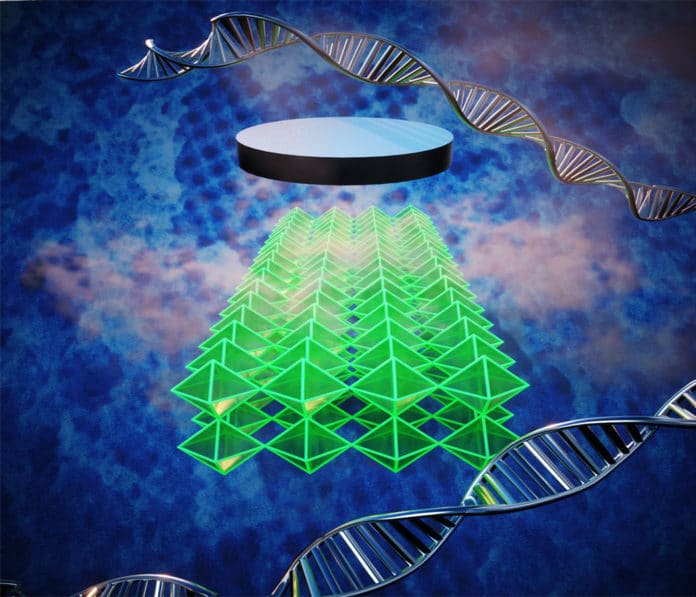Three-dimensional (3-D) nanostructured materials can conduct electricity without resistance. According to scientists, it could be used in a range of quantum devices.
Such 3-D superconducting nanostructures could discover application in signal amplifiers to upgrade quantum computers’ speed and accuracy and ultrasensitive magnetic field sensors for medical imaging and subsurface geology mapping. However, traditional fabrication tools, for example, lithography, have been restricted to 1-D and 2-D nanostructures like superconducting wires and thin films.
Now, scientists from the U.S. Department of Energy’s (DOE) Brookhaven National Laboratory, Columbia University, and Bar-Ilan University in Israel have developed a platform for making 3-D superconducting nano-architectures with a prescribed organization.
As reported, this platform relies on the self-assembly of DNA into desired 3-D shapes at the nanoscale. In DNA self-assembly, a single long strand of DNA is folded by shorter complementary “staple” strands at specific locations—similar to origami, the Japanese art of paper folding.
Co-corresponding author Oleg Gang, leader of the Soft and Bio Nanomaterials Group at Brookhaven Lab’s Center for Functional Nanomaterials (CFN), said, “Because of its structural programmability, DNA can provide an assembly platform for building designed nanostructures. However, the fragility of DNA makes it seem unsuitable for functional device fabrication and nanomanufacturing that requires inorganic materials. In this study, we showed how DNA could serve as a scaffold for building 3-D nanoscale architectures that can be fully “converted” into inorganic materials like superconductors.”
To create this platform, scientists started with designing octahedral-shaped DNA origami “frames.” They then applied a DNA-programmable strategy so that these frames would assemble into desired lattices.
Using a chemistry technique, scientists coated the DNA lattices with silicon dioxide (silica). Doing so solidified the soft construction, which required a liquid environment to preserve its structure.
The team tailored the fabrication process, so the structures were true to their design, as confirmed by imaging at the CFN Electron Microscopy Facility and small-angle X-ray scattering at the Complex Materials Scattering beamline of Brookhaven’s National Synchrotron Light Source II (NSLS-II). These experiments demonstrated that the structural integrity was preserved after they coated the DNA lattices.
Gang said, “In its original form, DNA is completely unusable for processing with conventional nanotechnology methods. But once we coat the DNA with silica, we have a mechanically robust 3-D architecture to deposit inorganic materials on using these methods. This is analogous to traditional nanomanufacturing, in which valuable materials are deposited onto flat substrates, typically silicon, to add functionality.”
Yosi Yeshurun, Head of Bar-Ilan’s Institute of Superconductivity, said, “Previously, making 3-D nanosuperconductors involved a very elaborate and difficult process using conventional fabrication techniques. Here, we found a relatively simple way using Oleg’s DNA structures.”
At the Institute of Superconductivity, Yeshurun’s graduate student Lior Shani evaporated a low-temperature superconductor (niobium) onto a silicon chip containing a small sample of the lattices. The evaporation rate and silicon substrate temperature must be carefully controlled to ensure that niobium covered the sample, however, it didn’t enter entirely through. If that happened, a short could occur between the electrodes used for the electronic transport measurements.
Yeshurun said, “We cut a special channel in the substrate to ensure that the current would only go through the sample itself.”
“The measurements revealed a 3-D array of Josephson junctions or thin nonsuperconducting barriers through which superconducting current tunnels. Arrays of Josephson junctions are key to leveraging quantum phenomena in practical technologies, such as superconducting quantum interference devices for magnetic field sensing. In 3-D, more junctions can be packed into a small volume, increasing device power.”
Evan Runnerstrom, program manager for materials design at the U.S. Army Combat Capabilities Development Command Army Research Laboratory of the U.S. Army Research Office, which funded the work in part, said, “DNA origami has been producing beautiful and ornate 3-D nanoscale structures for almost 15 years, but DNA itself is not necessarily a useful functional material. Prof. Gang has shown that you can leverage DNA origami as a template to create useful 3-D nanostructures of functional materials, like superconducting niobium. This ability to arbitrarily design and fabricate complex 3-D-structured functional materials from the bottom-up will accelerate the Army’s modernization efforts in areas like sensing, optics, and quantum computing.”
Gang said, “We demonstrated a pathway for how complex DNA organizations can be used to create highly nanostructured 3-D superconducting materials. This material conversion pathway gives us an ability to make various systems with interesting properties—not only superconductivity but also other electronic, mechanical, optical, and catalytic properties. We can envision it as a “molecular lithography,” where the power of DNA programmability is transferred to 3-D inorganic nanofabrication.”
Journal Reference:
- Shani, L., Michelson, A.N., Minevich, B., et al. DNA-assembled superconducting 3D nanoscale architectures. Nat Commun 11, 5697 (2020). DOI: 10.1038/s41467-020-19439-9
